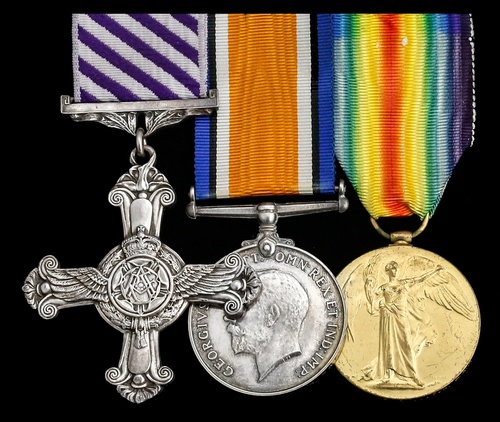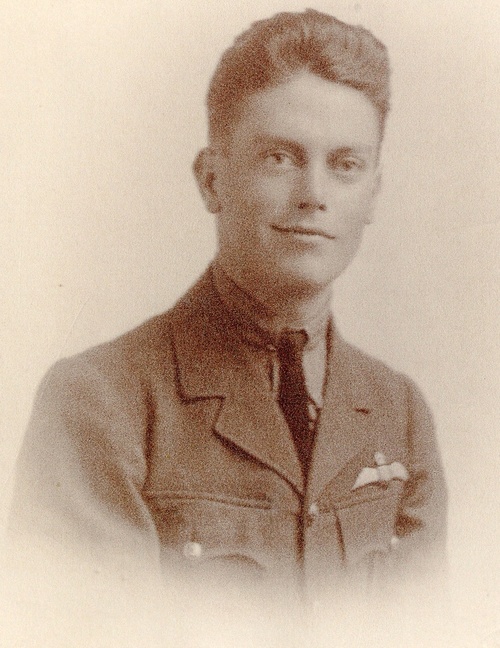Auction: 17003 - Orders, Decorations and Medals
Lot: 714
A fine Great War D.F.C. group of three awarded to Lieutenant C. S. L. Coulson, Royal Air Force, late Royal Flying Corps, a pilot who 'at all times set a brilliant example of courage and determination'
Following a hair-raising introduction to aerial combat in March 1918, when he was forced to land his badly shot-up Camel of No. 80 Squadron between advancing enemy troops and our lines, he went on to claim a Fokker triplane of Richthofen's 'Flying Circus' and wreak havoc on enemy ground forces in the battles of St. Quentin and the Marne
A survivor of numerous offensive patrols - and several further forced-landings - his combat career was curtailed by a brace of serious leg wounds collected in a determined attack on enemy ground forces in August 1918
Distinguished Flying Cross, G.V.R., unnamed as issued; British War and Victory Medals (Lieut. C. S. L. Coulson, R.A.F.), possible official correction to rank on first, good very fine (3)
D.F.C. London Gazette 2 November 1918. The original recommendation states:
'For conspicuous gallantry and skill in attacking enemy troops on the ground.
On 9 August 1918, he observed a party of enemy troops strongly manning a trench north of Morlancourt, who were firing at some of our infantry who were withdrawing to a trench to the west.
Time after time he dived on the enemy trench, firing the while at its occupants and distracting their attention from our troops. Eventually he was wounded twice in his right leg, but despite this he flew back to base.
He has carried out work of the greatest value during the battle of St. Quentin in March and during the battle of the Marne in July 1918, by attacking enemy troops on the ground, and he has at all times set a brilliant example of courage and determination.'
Charles Stanley Lomas Coulson was born in Derby in October 1898 and enlisted in the Artists' Rifles direct from his studies at Bloxham School, Oxford. Quickly commissioned 2nd Lieutenant on the General List in June 1917, he joined the Royal Flying Corps and qualified as a pilot.
Posted to No. 80 Squadron in France in early 1918, he first went into action in the unit's Camels in March and appears to have been slightly wounded in a combat over St. Quentin-Roupy on the 21st. The relevant combat report states that he was forced to land between advancing enemy troops and our outposts - 'Pilot escaped and machine abandoned.'
Three days later he was back in action, engaging enemy troops and transport with 400 rounds south of Rancourt, whilst on the 25th and 27th he survived further forced-landings, his Camel overturning on the second occasion.
Having then fought in a combat with eight enemy triplanes on 1 April, Coulson had a crash landing on returning from a test flight on the 24th - he misjudged his landing and 'turned on his nose'.
On 10 May, 80 Squadron had one of its toughest days, losing four pilots after a run-in with Richthofen's 'Flying Circus' over Borecourt. In the company of fellow pilots Captain Orlando Bridgeman and Lieutenant H.V. Barker, he claimed one Fokker triplane as out of control:
'I then dived on a Triplane, which was going down on another camel, and fired about 70 rounds into him. This E.A. immediately turned over on its back, and then went down in successive dives and stalls, and continued falling as far as I could see - which was about 3,000 feet. By this time I had collected two Triplanes on my tail. I succeeded in shaking them off, but was unable to get either of them in my line of fire …'
The following day, Coulson made a forced-landing at Beauval after another offensive patrol.
And so to the events of 9 August, when, as described in the recommendation for his D.F.C., he was twice wounded in the leg by enemy ground fire. As a consequence of those serious wounds, he was admitted to hospitals in Etaples and Boulogne, prior to being invalided home in early October.
Having then been placed on the Unemployed List in April 1919, Coulson attended Oxford University but was drowned in a punting accident in April 1921, aged 22.
Sold an original studio portrait photograph, in uniform, and a printed copy of the Army Orders in which his award of the D.F.C. was announced (No. 168 of 1 September 1918), in its original scroll forwarding box, together with a file of copied research.
Subject to 20% VAT on Buyer’s Premium. For more information please view Terms and Conditions for Buyers.
Sold for
£3,800







